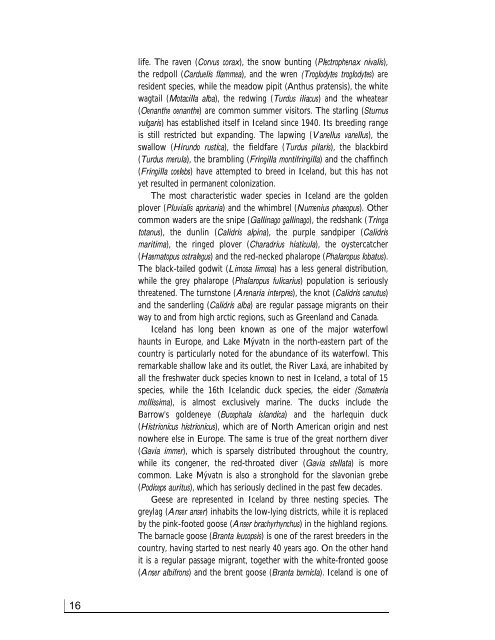BIOLOGICAL DIVERSITY IN ICELAND - Convention on Biological ...
BIOLOGICAL DIVERSITY IN ICELAND - Convention on Biological ...
BIOLOGICAL DIVERSITY IN ICELAND - Convention on Biological ...
- No tags were found...
You also want an ePaper? Increase the reach of your titles
YUMPU automatically turns print PDFs into web optimized ePapers that Google loves.
16life. The raven (Corvus corax), the snow bunting (Plectrophenax nivalis),the redpoll (Carduelis flammea), and the wren (Troglodytes troglodytes) areresident species, while the meadow pipit (Anthus pratensis), the whitewagtail (Motacilla alba), the redwing (Turdus iliacus) and the wheatear(Oenanthe oenanthe) are comm<strong>on</strong> summer visitors. The starling (Sturnusvulgaris) has established itself in Iceland since 1940. Its breeding rangeis still restricted but expanding. The lapwing (Vanellus vanellus), theswallow (Hirundo rustica), the fieldfare (Turdus pilaris), the blackbird(Turdus merula), the brambling (Fringilla m<strong>on</strong>tifringilla) and the chaffinch(Fringilla coelebs) have attempted to breed in Iceland, but this has notyet resulted in permanent col<strong>on</strong>izati<strong>on</strong>.The most characteristic wader species in Iceland are the goldenplover (Pluvialis apricaria) and the whimbrel (Numenius phaeopus). Othercomm<strong>on</strong> waders are the snipe (Gallinago gallinago), the redshank (Tringatotanus), the dunlin (Calidris alpina), the purple sandpiper (Calidrismaritima), the ringed plover (Charadrius hiaticula), the oystercatcher(Haematopus ostralegus) and the red-necked phalarope (Phalaropus lobatus).The black-tailed godwit (Limosa limosa) has a less general distributi<strong>on</strong>,while the grey phalarope (Phalaropus fulicarius) populati<strong>on</strong> is seriouslythreatened. The turnst<strong>on</strong>e (Arenaria interpres), the knot (Calidris canutus)and the sanderling (Calidris alba) are regular passage migrants <strong>on</strong> theirway to and from high arctic regi<strong>on</strong>s, such as Greenland and Canada.Iceland has l<strong>on</strong>g been known as <strong>on</strong>e of the major waterfowlhaunts in Europe, and Lake Mývatn in the north-eastern part of thecountry is particularly noted for the abundance of its waterfowl. Thisremarkable shallow lake and its outlet, the River Laxá, are inhabited byall the freshwater duck species known to nest in Iceland, a total of 15species, while the 16th Icelandic duck species, the eider (Somateriamollissima), is almost exclusively marine. The ducks include theBarrow's goldeneye (Bucephala islandica) and the harlequin duck(Histri<strong>on</strong>icus histri<strong>on</strong>icus), which are of North American origin and nestnowhere else in Europe. The same is true of the great northern diver(Gavia immer), which is sparsely distributed throughout the country,while its c<strong>on</strong>gener, the red-throated diver (Gavia stellata) is morecomm<strong>on</strong>. Lake Mývatn is also a str<strong>on</strong>ghold for the slav<strong>on</strong>ian grebe(Podiceps auritus), which has seriously declined in the past few decades.Geese are represented in Iceland by three nesting species. Thegreylag (Anser anser) inhabits the low-lying districts, while it is replacedby the pink-footed goose (Anser brachyrhynchus) in the highland regi<strong>on</strong>s.The barnacle goose (Branta leucopsis) is <strong>on</strong>e of the rarest breeders in thecountry, having started to nest nearly 40 years ago. On the other handit is a regular passage migrant, together with the white-fr<strong>on</strong>ted goose(Anser albifr<strong>on</strong>s) and the brent goose (Branta bernicla). Iceland is <strong>on</strong>e of
















